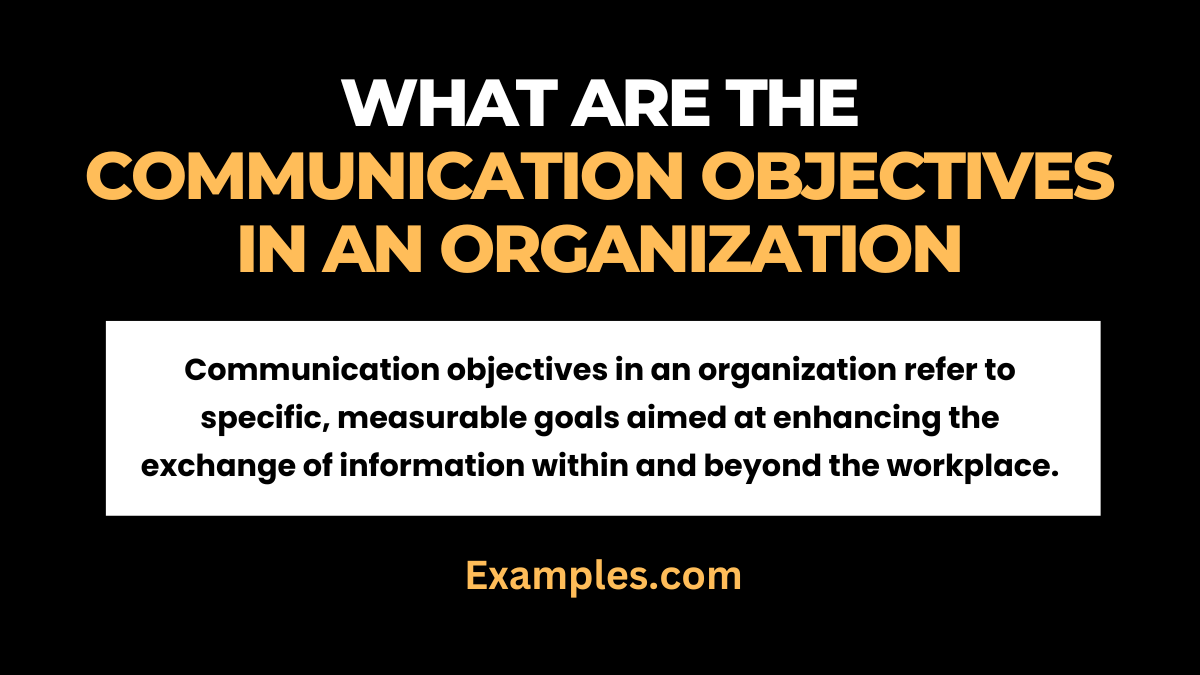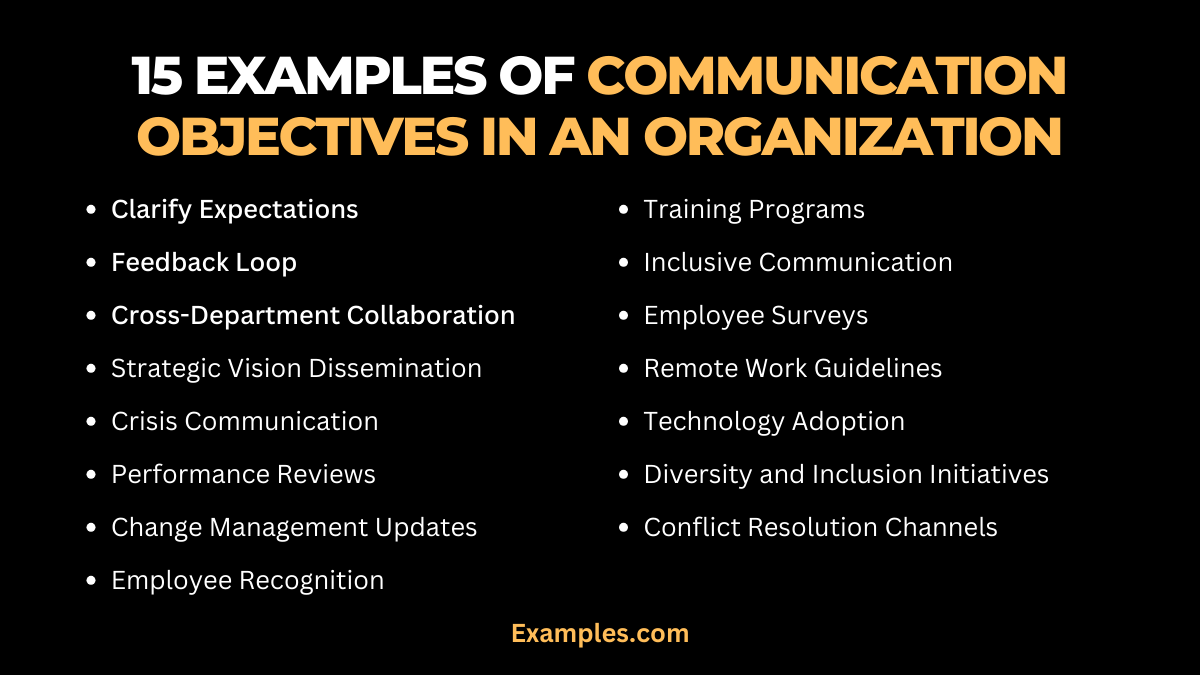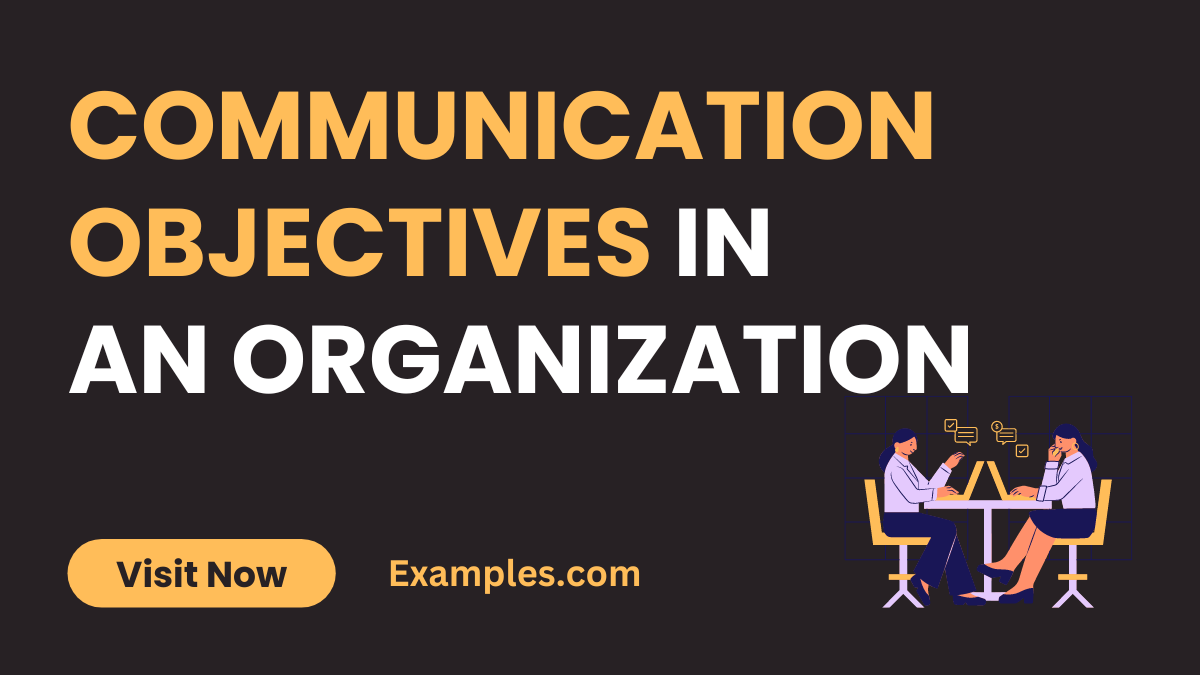14+ Communication Objectives in an Organization Examples
In the dynamic landscape of organizations, effective communication is paramount. This comprehensive guide to Communication Objectives in an Organization delves into key strategies, showcasing diverse Communication Examples. Explore the intricacies of internal communication, strategy formulation, and goal alignment, guiding your team towards success. Uncover practical insights, essential tips, and real-world examples to enhance your organizational communication game. Elevate your workplace dynamics with this holistic guide.
What are the Communication Objectives in an Organization

Communication objectives in an organization refer to specific, measurable goals aimed at enhancing the exchange of information within and beyond the workplace. These objectives may include fostering collaboration, ensuring clarity in messaging, and aligning communication strategies with organizational goals. Clear communication objectives are essential for promoting transparency, building a cohesive work environment, and achieving overall success in organizational endeavours.
15 Examples of Communication Objectives In An Organization
Effective communication objectives in an organization are pivotal for seamless operations. Clear and concise messaging fosters collaboration, boosts employee morale, and ensures organizational success. Achieving transparency, aligning with goals, and adapting to diverse communication styles are paramount.

- Clarify Expectations: Communicate project expectations clearly to minimize misunderstandings.
- Feedback Loop: Establish a regular feedback system for open communication channels.
- Cross-Department Collaboration: Facilitate cross-departmental communication to enhance synergy.
- Strategic Vision Dissemination: Effectively convey the organization’s strategic vision to align teams.
- Crisis Communication: Develop protocols for transparent communication during crises or emergencies.
- Performance Reviews: Implement constructive feedback mechanisms for employee performance evaluations.
- Change Management Updates: Clearly communicate changes in policies, procedures, or structure to ensure smooth transitions.
- Employee Recognition: Establish channels to celebrate and communicate employee achievements across the organization.
- Training Programs: Communicate training opportunities to enhance employee skills and knowledge.
- Inclusive Communication: Foster an inclusive environment by addressing diverse communication needs within the organization.
- Employee Surveys: Use surveys to gather feedback and continuously improve communication strategies.
- Remote Work Guidelines: Clearly communicate guidelines and expectations for remote work scenarios.
- Technology Adoption: Communicate updates and training related to the adoption of new technologies within the organization.
- Diversity and Inclusion Initiatives: Promote diversity and inclusion through effective communication of related initiatives.
- Conflict Resolution Channels: Establish clear channels for conflict resolution, ensuring a harmonious work environment.
Communication Objectives in an Organization at Work
In a workplace, communication objectives focus on fostering a collaborative environment, ensuring clarity in directives, and maintaining open channels for feedback. Seamless communication enhances productivity, minimizes errors, and cultivates a positive organizational culture.
- Team Collaboration: Utilize project management tools for effective collaboration.
- Performance Feedback: Implement regular performance reviews for constructive feedback.
- Meeting Efficiency: Set clear agendas and timeframes to streamline meetings.
- Task Delegation: Use concise communication to assign tasks and responsibilities.
- Conflict Resolution Channels: Establish protocols for addressing and resolving workplace conflicts.
- Employee Recognition: Acknowledge achievements publicly through newsletters or meetings.
- Training Programs: Communicate training opportunities to enhance employee skills.
- Inclusive Communication: Promote inclusivity through accessible and diverse communication methods.
- Employee Surveys: Conduct surveys to gather feedback and improve organizational processes.
- Change Management Updates: Clearly communicate changes and updates during organizational transitions.
Communication Objectives in an Organization at University
In an educational setting, communication objectives aim to facilitate effective information flow among students, faculty, and staff. Clear communication supports academic success, community engagement, and a positive learning environment.
- Class Announcements: Utilize online platforms for timely class announcements and updates.
- Feedback Mechanism: Establish efficient channels for students to provide feedback on courses.
- Research Collaboration: Encourage interdisciplinary collaboration through transparent communication.
- Event Promotion: Effectively promote university events to foster community engagement.
- Advisory Services: Provide clear communication channels for academic and career advisory services.
- Student Organizations: Facilitate communication within student organizations for enhanced participation.
- Library Resources: Communicate library resources and services to support student learning.
- Online Learning Guidelines: Clearly articulate guidelines and expectations for online learning platforms.
- Internship Opportunities: Inform students about available internships through various communication channels.
- Campus Safety Updates: Communicate safety measures and updates to ensure student well-being.
What Are the Main Objectives of Organizational Communication?
Organizational communication objectives form the backbone of effective interaction within a company. These objectives guide the communication strategy to achieve specific outcomes and foster a positive work environment.
- Ensure Clarity and Understanding
Objective: To convey information clearly, minimizing misunderstandings and ensuring a shared understanding among employees. - Facilitate Team Collaboration
Objective: Promote seamless collaboration by establishing effective communication channels that enhance teamwork and productivity. - Provide Timely and Relevant Information
Objective: Deliver information in a timely manner, keeping employees informed about organizational changes, updates, and events. - Encourage Open Communication
Objective: Foster a culture of openness, where employees feel comfortable expressing their thoughts, ideas, and concerns. - Support Organizational Goals
Objective: Align communication efforts with overall organizational objectives, ensuring that every message contributes to the company’s success. - Build a Positive Organizational Culture
Objective: Use communication to cultivate a positive workplace culture, emphasizing values, shared goals, and mutual respect.
What Is the Importance of Communication Objectives in an Organization?
Effective communication objectives are vital for an organization’s success, influencing various aspects of its functioning.
- Enhanced Productivity
Clear communication objectives minimize confusion, streamline processes, and boost overall productivity. - Employee Engagement
Well-defined communication goals foster engagement, as employees feel informed, valued, and connected to the organization. - Conflict Resolution
- Communication objectives aid in resolving conflicts by providing structured channels for addressing issues and concerns.
- Innovation and Creativity
Clear communication fosters an environment where innovative ideas can be freely exchanged, promoting creativity and problem-solving. - Adaptation to Change
Communication objectives support smooth transitions during organizational changes, ensuring that employees understand and adapt to new initiatives. - Customer Satisfaction
Effective internal communication positively impacts external communication, contributing to better customer relations and satisfaction.
In summary, mastering communication objectives in an organization is pivotal for success. From addressing challenges to defining clear goals and fostering a positive culture, effective communication enhances productivity, collaboration, and innovation. Embracing these insights and examples ensures a comprehensive guide, empowering organizations to navigate the intricate landscape of communication with clarity and purpose.



